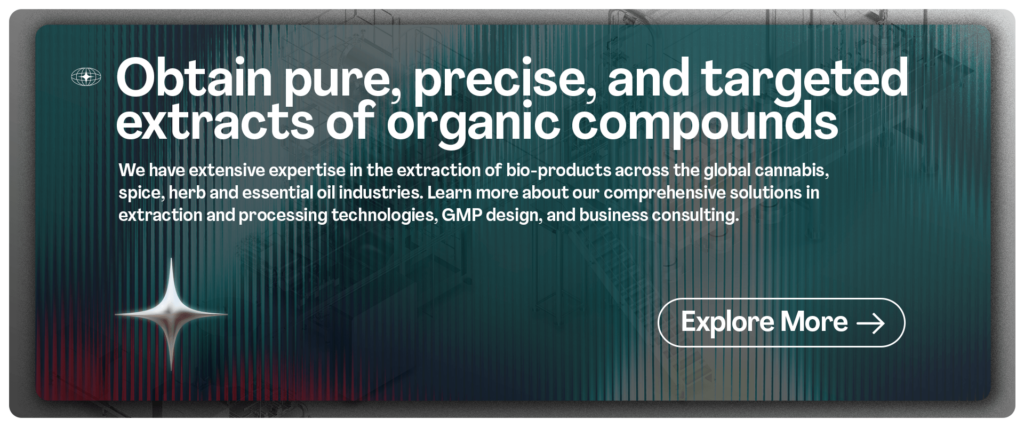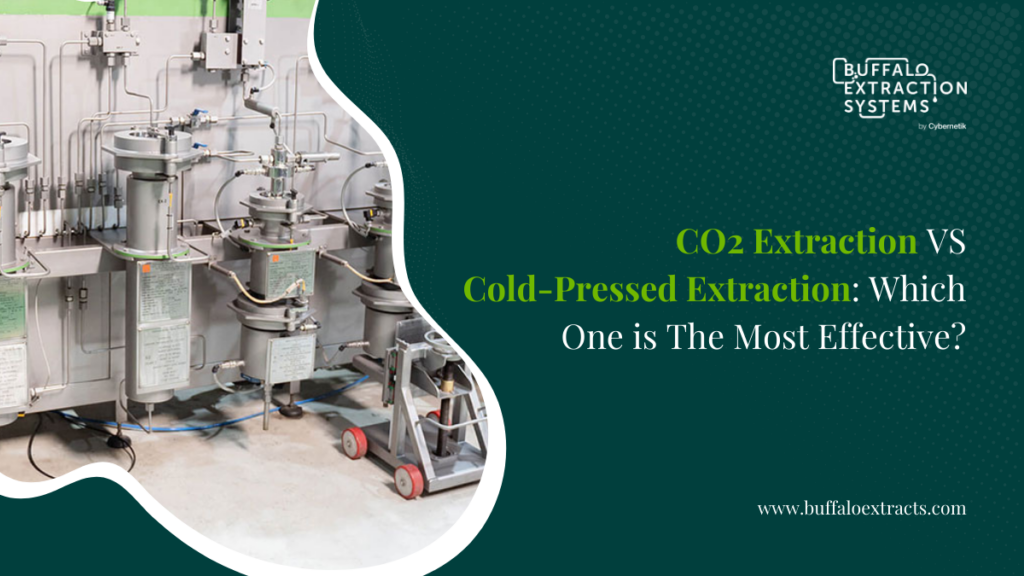Exploring Extraction Methods: CO2 Extraction vs. Cold-Pressed Extraction
In botanical extraction, the quest for obtaining valuable compounds from plant materials has led to the development of various methods, each with unique strengths and applications. Two prominent techniques, CO2 extraction and cold-pressed extraction, have garnered attention for their efficacy in obtaining essential oils and bioactive substances.
This guide aims to shed light on the characteristics, effectiveness, and suitability of these methods in different contexts. Whether you seek precision in extracting specific compounds or the preservation of natural flavors, understanding the nuances of CO2 extraction for essential oils and cold-pressed extraction is crucial in making informed decisions for your extraction needs.
CO2 Extraction
CO2 extraction, short for supercritical fluid extraction process (SCFE) using carbon dioxide, is a cutting-edge method used to extract essential oils and various bioactive compounds from botanical materials, such as botanical extracts for cosmetics. In this process, carbon dioxide (CO2) is pressurized and heated until it reaches a supercritical state, where it behaves as both a gas and a liquid. This supercritical CO2 is then used to extract desired compounds from the plant material.

The process can be fine-tuned by adjusting temperature and pressure, making it highly versatile for extracting specific compounds with precision. CO2 extraction is known for its effectiveness in obtaining a wide range of compounds while maintaining a high degree of purity, making it a preferred choice in industries such as pharmaceuticals and the cannabis sector.
- Process: Application of supercritical fluid extraction involves CO2 in its supercritical state. This is a state between liquid and gas. In this state, the gas behaves both as a gas and a liquid. This process involves three main steps extraction, separation, and recovery. CO2 is pressurized and passed through the plant material. The supercritical CO2 will penetrate through the matrix of the raw material and dissolve the essential compounds. By adjusting the temperature and pressure selective extractions can be done. Lower temperatures and pressures can extract volatile compounds while higher pressures can extract more non-polar compounds. At lower pressure and temperature, the dissolved compounds separate from carbon dioxide, and are then recovered.
- Effectiveness: CO2 extraction is highly effective at extracting a wide range of compounds, including CO2 extraction for essential oils and cannabinoids from cannabis plants, as well as other bioactive substances from botanicals. It can be fine-tuned for target-specific compounds, making it suitable for industries where precision is crucial, such as pharmaceuticals and aromatherapy.
- Quality: The ability to control temperature and pressure precisely during CO2 extraction results in high quality extracts. This method is particularly valuable for preserving sensitive compounds that may degrade at higher temperatures.
- Safety: CO2 extraction is generally considered safe because it doesn’t involve the use of chemical solvents. Once the process is complete, the CO2 can be easily removed, leaving behind a clean and pure extract without residual solvents.
Cold-Pressed Extraction
Cold-pressed extraction, in contrast, is a mechanical extraction method primarily employed for obtaining oils from plant sources such as seeds, nuts, and fruits. The key feature of this technique is that it operates at low temperatures, typically below 120°F (49°C), to avoid the application of heat. The plant material is mechanically pressed or crushed to release the oil, and this spice oil extraction method is particularly renowned for its ability to preserve the natural flavors and aromas of the source material.
Cold-pressed oils, such as olive oil and citrus oils, are highly regarded for their high quality and are often used in culinary and cosmetic applications. Cold-pressed extraction is valued for its simplicity, safety, and its capacity to create premium, natural products.
- Process: Cold-pressed extraction is a mechanical method used primarily for obtaining oils from various plant sources, such as fruits, seeds, and nuts.The process involves crushing or pressing the plant material at low temperatures, usually below 120°F (49°C), to release the oil. This avoids the application of heat, which can alter the flavor and composition of the oil.
- Effectiveness: Cold-pressed extraction is particularly effective for obtaining oils from seeds and fruits, such as olive oil, coconut oil, and citrus oils. It is often used for culinary and cosmetic purposes.While it is excellent at retaining the natural flavors and aromas of the source material, it may not capture as wide a range of compounds as CO2 extraction.
- Quality: Cold-pressed oils are renowned for their high quality and purity. They are often considered premium products due to their natural taste and aroma profiles, making them popular in gourmet cooking and skincare.
- Safety: Cold-pressed extraction is generally safe and straightforward, as it doesn’t involve the use of chemical solvents or high temperatures. It is a gentle method that preserves the integrity of the oil.
Conclusion
In the ever-evolving landscape of extraction techniques, the choice between CO2 extraction and cold-pressed extraction ultimately hinges on the goals of the extraction process. Supercritical CO2 extraction process emerges as a powerhouse, offering precision, versatility, and the capability to obtain a wide spectrum of compounds. This method finds its place in industries ranging from pharmaceuticals to the medical cannabis extraction sector, where the controlled extraction of specific molecules is paramount.
On the other hand, cold-pressed extraction excels in preserving the integrity of oils derived from seeds and fruits, appealing to connoisseurs seeking natural flavors and aromas. As these methods continue to evolve and adapt, they enrich the array of possibilities for harnessing the essence of plants, catering to diverse industries and consumer preferences. The choice is no longer just about extraction; it is about crafting experiences and products that resonate with the desires of a dynamic market.

